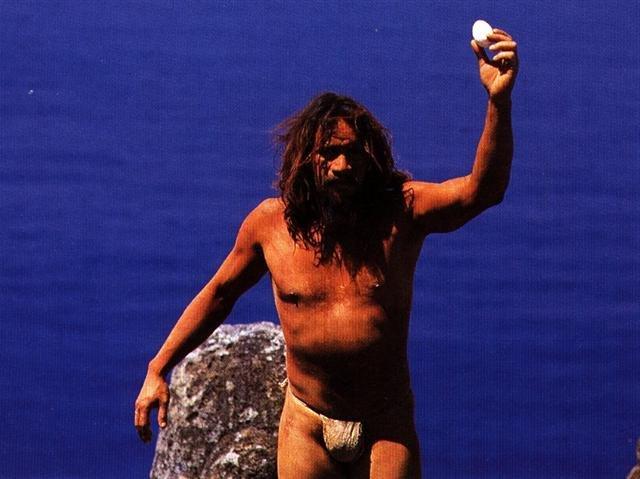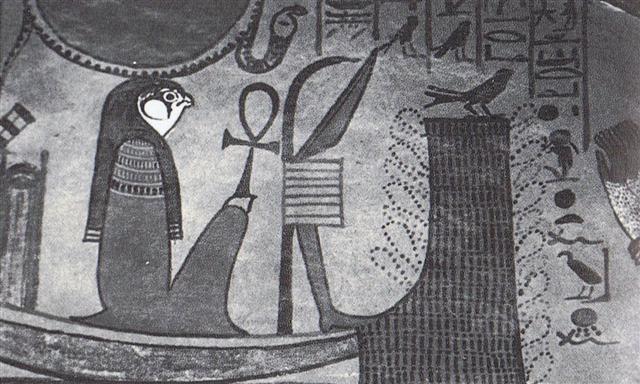On Easter Island spring was dependent on the return of the sooty terns (manu tara) who would come flying in from the north to lay their precious eggs on the 3 islets outside the southwestern corner of the island.  Another name for these birds was Sea Swallow, which I think is telling us 'Sea' (winter time) is being 'swallowed' at their arrival. Also the Ship of Sun in ancient Egypt had a swallow up front when it sailed on the back side:
3 feathers in front could have been associated with these 3 islets (motu). The southern spring arrives at the opposite time of the year compared to the situation north of the equator - it is like a mirror image of the northern spring. Thus the great bend in the Eridanus river of time could on Easter Island have been thought of as coming after the 3 'fiery feathers' in the Belt of Orion. Sun will pass the declination of the Belt of Orion before reaching his southern limit the Tropic of Capricorn, not very far from the latitude of Easter Island. After the Bird Man had won the race and got hold of the first manu tara egg he would rule the island like a king until spring next year. But it was his servant who took the risk of swimming among the sharks: "On the south-western tip of Easter Island, at Orongo, up near the ragged edge of the Rano Kau crater, are four small holes very precisely pecked through the bedrock just beside a large Ahu. Since Orongo is known to have been an important ritual centre, these holes attracted the attention of the Norwegian Archaeological Expedition which visited the island in 1955-56. They were studied by Dr Edwin Ferdon. After making detailed observations at the solstices and the equinoxes he concluded: 'it can definitely be stated that the complex of four holes constituted a sun-observation device'. As well as one Ahu, Orongo also formerly had one Moai, a unique specimen, carved out of basalt, that was removed to the British Museum in 1868. Perched on a headland with a precipitous drop to the ocean on one side and the gigantic, reed-filled crater of Rano Kau on the other, the main remaining feature of the site is a conglomeration of 54 squat oval houses with massively thick walls of horizontal stone slabs and domed corbel-vaulted ceilings. The ritual that took place in this setting was the annual 'birdman' contest which was held each September - the month of the spring equinox in the southern hemisphere. The origins of this apparently bizarre ceremony are entirely unknown. Its centrepiece was a physical quest for the egg of a sooty tern and specifically for the first tern's egg of the season to be laid on the bird island of Moto-Nui which stands offshore just under a mile to the south-west of the Orongo headland. The quest was undertaken on behalf of noble patrons by young champions called hopu manu ('servants of the bird') and officiated by the learned keepers of the inscribed Rongorongo tablets. On a signal from these scribes the hopu manu clambered down the cliffs of Orongo and paddled themselves out to the island on small conical reed floats called pora. The first to return with a sooty tern's egg would then hand it triumphantly to his patron, who would forthwith be declared the 'Tangatu-Manu' - the sacred 'birdman'. He would be honoured as a king throughout the following year, during which he would shave his head and paint it bright red. At the same time a curious petroglyph of a long-beaked bird-headed man would be carved to represent him on the rocks of Orongo." (Peter H. Buck, Te Rangi Hiroa, Vikings of the Pacific.)
Among the Mayans 'fire' was said to be originating from the 3 'stones' of the Belt of Orion:  The 3 islets outside Easter Island were also 'stones', standing there in the water like Orion.
... Tautoru (3 stones, The Belt of Orion) could correspond to Nga Kope Ririva, the youths who are 'standing in the water'. Tautoru is just below the celestial equator, i.e. down in the water if the southern hemisphere is regarded as 'water' ... |


